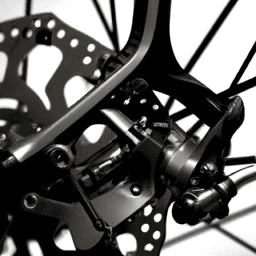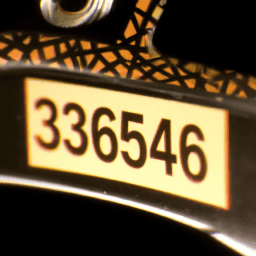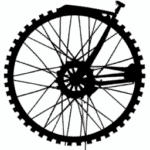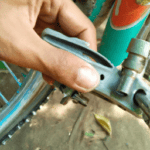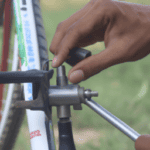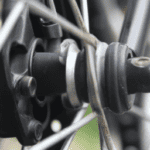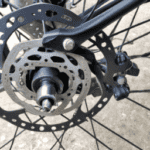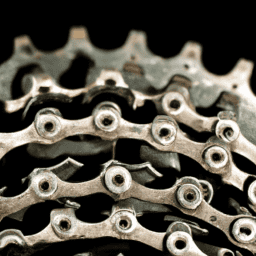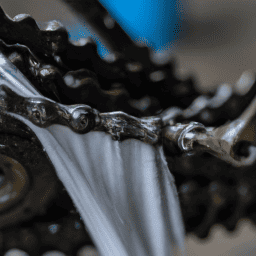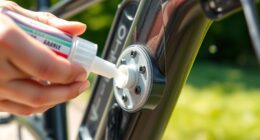Riding my bike along the roadway, I’m aware that I might have to halt abruptly at any time. Fortunately, my reliable brakes are there to decelerate my speed and prevent any potential accidents. Ever curious about the mechanism behind these brakes?
In this article, I’ll be exploring the science behind bicycle braking and the different types of brakes available. From the classic rim brakes to the more modern disc brakes, there are a variety of ways to stop a bicycle. But how do they each work? Understanding the mechanics behind these systems can not only make you a better cyclist, but also help you properly maintain and troubleshoot your brakes.
So, let’s dive into the world of bicycle brakes and discover how they keep us safe on the road.
Key Takeaways
- Bicycle brakes work through friction between brake pads and the wheel rim/rotor.
- Proper maintenance, including regular inspection and replacement of brake pads, is essential for optimal brake performance and safety.
- Hydraulic brakes use fluid to transfer force, while mechanical brakes use cables, and both types can be used for rim or disc brakes.
- Factors affecting brake function include friction coefficients and braking force distribution, with a well-balanced distribution being essential for safe and effective stopping.
Overview of Bicycle Brakes
So, you’re probably wondering how your bike’s brakes actually stop you – well, it’s all about friction between the brake pads and the wheel rim.
There are two main types of brake pads: rubber and metallic. Rubber pads are quieter and provide better modulation, but wear out faster. Metallic pads provide better stopping power and last longer, but can be noisy and harsh on the rims.
When it comes to the mechanism that activates the brake pads, there are two main types of brakes: hydraulic and mechanical. Hydraulic brakes use fluid to transfer force from the brake lever to the brake pads. They offer better modulation and require less effort to apply than mechanical brakes.
Mechanical brakes use cables to transfer force from the brake lever to the brake pads. They are simpler and more cost-effective, but require more hand strength and are less precise.
Rim brakes, which use friction between the brake pads and the wheel rim to slow down the bike, can be either hydraulic or mechanical.
Rim Brakes
You’ll love how efficiently rim brakes stop your bike with just a simple squeeze of the brake lever. Rim brakes work by using brake pads that press against the rim of the wheel to slow down or stop the bike. The brake pads are made of rubber or other materials that provide friction against the rim.
When you squeeze the brake lever, the cable tension increases, causing the brake pads to press against the rim. The harder you squeeze the lever, the more cable tension is applied, and the more force is applied to the brake pads, resulting in a stronger braking force.
To ensure that your rim brakes work properly, it’s important to maintain the correct cable tension. If the cable tension is too loose, the brake pads won’t make enough contact with the rim, resulting in weak braking. On the other hand, if the cable tension is too tight, the brake pads will rub against the rim even when you’re not braking, causing unnecessary wear and tear on both the brake pads and the rim.
By adjusting the cable tension, you can ensure that your rim brakes provide optimal stopping power when you need it.
Moving on to the next section, disc brakes offer a different type of braking system that provides even more stopping power and control.
Disc Brakes
Get ready for a thrilling ride with disc brakes, as they give you the ultimate control and stopping power that will make your heart race.
Disc brakes are a type of braking system that uses a metal rotor, usually made of steel, attached to the hub of the wheel. When the brake lever is pulled, brake pads, often made of resin or metallic compounds, are forced onto the rotor, creating friction that slows down the wheel.
One of the advantages of disc brakes is their increased stopping power, especially in wet or muddy conditions. However, this also means that they produce more heat than rim brakes, which can cause the brake pads to wear out faster.
Proper disc brake maintenance, including regularly checking and replacing worn brake pads, is essential to ensure the best performance and safety. Upgrading disc brakes can also improve their performance, with options such as larger rotor sizes or different brake pad materials.
Transitioning into the subsequent section about "the science behind braking,"it’s important to understand how the design and materials of disc brakes affect their stopping power and durability.
The Science Behind Braking
Understanding the science behind how brakes function can make you appreciate the engineering behind your bike even more. When you squeeze the brake lever, the brake pads come in contact with the wheel rim or rotor, creating friction that slows down the bike.
This simple action is made possible by the complex interplay of multiple factors, such as the friction coefficients of the brake pads and the wheel surface, as well as the braking force distribution between the front and rear brakes.
To fully appreciate the science behind braking, consider the following nested bullet point list:
-
Friction coefficients:
-
The friction coefficient is a measure of the force required to move one object over another, and it plays a critical role in how your brakes function.
-
The higher the coefficient, the greater the stopping power.
-
Braking force distribution:
-
The distribution of braking force between the front and rear brakes is essential for maintaining stability and preventing skidding.
-
A well-balanced distribution can help you stop quickly and safely, especially in emergency situations.
When it comes to bike maintenance and troubleshooting, understanding how your brakes work can help you diagnose and fix any issues that may arise.
Maintenance and Troubleshooting
Maintaining your bike and keeping it in top shape is crucial for ensuring a smooth and safe ride. When it comes to bicycle brakes, regular maintenance is especially important. One of the most common issues with brakes is worn out brake pads. Over time, the rubber on the brake pads will wear down, reducing their effectiveness. To replace the brake pads, you’ll need to remove the old ones and install new ones. This is a relatively simple process that can be done with a few basic tools. When replacing the brake pads, be sure to choose pads that are compatible with your bike’s braking system.
Another issue that can arise with bicycle brakes is adjusting cable tension. If your brakes feel loose or unresponsive, it may be due to loose cable tension. To adjust the tension, begin by locating the barrel adjuster on the brake lever. This is a small knob or screw that can be turned to increase or decrease tension in the brake cable. Turn the knob or screw clockwise to increase tension and counterclockwise to decrease tension. Once you’ve adjusted the tension, test the brakes to ensure they are working properly. By learning how to troubleshoot and maintain your bike’s brakes, you can ensure a safe and enjoyable ride every time.
| Brake Pad Replacement | Adjusting Cable Tension | ||
|---|---|---|---|
| Remove old brake pads | Locate barrel adjuster on brake lever | ||
| Install new brake pads | Turn knob/screw clockwise to increase tension | ||
| Choose compatible pads | Turn knob/screw counterclockwise to decrease tension | ||
| Use basic tools | Test brakes to ensure proper function | Adjust as needed and fine-tune if necessary. |
Frequently Asked Questions
What is the maximum weight capacity for bicycle brakes?
As a cyclist, I know that weight limitations and brake pad compatibility are important factors to consider. The maximum weight capacity for bicycle brakes depends on the specific model and type, and it’s crucial to ensure that the brake pads are compatible with your bike.
Can you use different brake pads on the same type of brake system?
Did you know that brake pad compatibility can affect a bike’s stopping power? While similar pads may fit the same brake system, performance differences can occur. Always check compatibility to ensure optimal braking performance.
How long do brake cables typically last before needing replacement?
Brake cables typically need replacement after 1-2 years of regular use. Signs of wear include fraying, kinks, or rust. Regular cable maintenance can extend their lifespan.
Is it safe to use worn-out brake pads in an emergency situation?
As a bike mechanic, I do not recommend using worn-out brake pads in emergency braking situations. The material becomes less effective over time, increasing stopping distance. Always prioritize safety and replace worn-out brake pads promptly.
How do different weather conditions affect the performance of bicycle brakes?
In rainy weather, braking efficiency decreases due to reduced friction between the brake pads and the wet rims. Extreme temperatures can also affect brake pads, causing them to harden or wear out faster.
Conclusion
In conclusion, understanding how bicycle brakes work is crucial for any cyclist out there. Whether you prefer rim brakes or disc brakes, the principles behind their operation are the same.
As I’ve mentioned earlier, braking is all about converting kinetic energy into heat energy, and that’s where the brake pads come in. By applying pressure to the rim or rotor, the pads slow down the wheel, bringing the bike to a halt.
But there’s more to braking than just pressing on the levers. Proper maintenance and troubleshooting are essential to ensure your brakes are functioning correctly. By keeping an eye on your brake pads, cables, and calipers, you can identify any issues that may arise and fix them before they become a safety hazard.
Remember, brakes are one of the most critical components of your bike, and neglecting them could lead to disastrous consequences.
In the end, understanding the science behind braking not only makes you a better cyclist but also gives you a deeper appreciation for the engineering that goes into creating these essential parts. As the great inventor Thomas Edison once said, "To invent, you need a good imagination and a pile of junk."And while bicycle brakes may not be junk, they are a testament to human ingenuity and the power of innovation.
So next time you hit the brakes on your bike, take a moment to reflect on the beauty of this simple yet vital technology.
